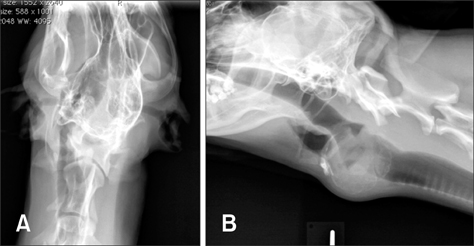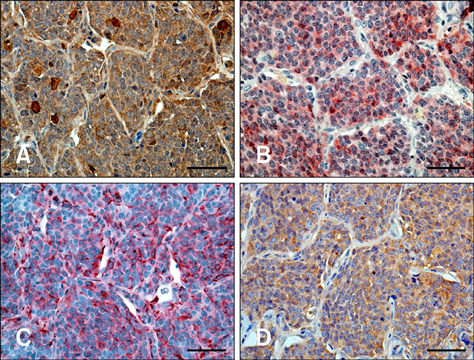J Vet Sci.
2014 Sep;15(3):449-453. 10.4142/jvs.2014.15.3.449.
Histopathological and immunohistochemical findings of primary and metastatic medullary thyroid carcinoma in a young dog
- Affiliations
-
- 1Department of Biomedical Sciences and Pathobiology, Virginia-Maryland Regional College of Veterinary Medicine, Virginia Tech, Blacksburg, VA 24061, USA. pablop@vt.edu
- 2Department of Comparative Pathobiology, Purdue University, West Lafayette, IN 47907, USA.
- 3Department of Small Animal Clinical Sciences, Virginia-Maryland Regional College of Veterinary Medicine, Virginia Tech, Blacksburg, VA 24061, USA.
- KMID: 2155631
- DOI: http://doi.org/10.4142/jvs.2014.15.3.449
Abstract
- This report describes the gross, histological, and immunohistochemical features of medullary thyroid carcinoma (MTC) with pulmonary metastases in a young dog. Sheets of pleomorphic cells supported by fibrous stroma characterized the primary mass, while metastatic nodules had a neuroendocrine pattern. Despite differing histologic features, all masses showed marked immunoreactivity against calcitonin and multiple neuroendocrine markers consistent with MTC. Although MTC is a well-recognized entity, it may be difficult to distinguish this mass from other thyroid neoplasms, necessitating immunohistochemical characterization.
MeSH Terms
Figure
Reference
-
1. Barber LG. Thyroid tumors in dogs and cats. Vet Clin North Am Small Anim Pract. 2007; 37:755–773.
Article2. Boorman GA, Hollander CF. Animal model of human disease: medullary carcinoma of the thyroid. Am J Pathol. 1976; 83:237–240.3. Carver JR, Kapatkin A, Patnaik AK. A comparison of medullary thyroid carcinoma and thyroid adenocarcinoma in dogs: a retrospective study of 38 cases. Vet Surg. 1995; 24:315–319.
Article4. Erickson LA, Lloyd RV. Practical markers used in the diagnosis of endocrine tumors. Adv Anat Pathol. 2004; 11:175–189.
Article5. Fischer S, Asa SL. Application of immunohistochemistry to thyroid neoplasms. Arch Pathol Lab Med. 2008; 132:359–372.
Article6. Fox JG, Dangler CA, Snyder SB, Richard MJ, Thilsted JP. C-cell carcinoma (medullary thyroid carcinoma) associated with multiple endocrine neoplasms in a ferret (Mustela putorius). Vet Pathol. 2000; 37:278–282.
Article7. Harmelin A, Nyska A, Aroch I, Yakobson B, Stem S, Orgad U, Waner T. Canine medullary thyroid carcinoma with unusual distant metastases. J Vet Diagn Invest. 1993; 5:284–288.
Article8. Hirayama K, Kagawa Y, Nihtani K, Taniyama H. Thyroid C-cell carcinoma with amyloid in a red fox (Vulpes vulpes schrenchki). Vet Pathol. 1999; 36:342–344.
Article9. Holscher MA, Davis BW, Wilson RB, Hunt KL, Berry KK. Ectopic thyroid tumor in a dog: thyroglobulin, calcitonin, and neuron-specific enolase immunocytochemical studies. Vet Pathol. 1986; 23:778–779.
Article10. Kiupel M, Capen C, Miller M, Smedley R. Histological Classification of Tumors of the Endocrine System of Domestic Animals. Washington DC: Armed Forces Institute of Pathology;2008. Vol. 12:p. 64–84.11. Krisch K, Krisch I, Horvat G, Neuhold N, Ulrich W. The value of immunohistochemistry in medullary thyroid carcinoma: a systematic study of 30 cases. Histopathology. 1985; 9:1077–1089.
Article12. Kuwamura M, Shirota A, Yamate J, Kotani T, Ohashi F, Sakuma S. C-cell adenoma containing variously sized thyroid follicles in a horse. J Vet Med Sci. 1998; 60:387–389.
Article13. Leblanc B, Parodi AL, Lagadic M, Hurtrel M, Jobit C. Immunocytochemistry of canine thyroid tumors. Vet Pathol. 1991; 28:370–380.
Article14. Leblanc B, Paulus G, Andreu M, Bonnet MC. Immunocytochemistry of thyroid C-cell complexes in dogs. Vet Pathol. 1990; 27:445–452.
Article15. Lee JJ, Larsson C, Lui WO, Höög A, Von Euler H. A dog pedigree with familial medullary thyroid cancer. Int J Oncol. 2006; 29:1173–1182.
Article16. Moore FM, Kledzik GS, Wolfe HJ, DeLellis RA. Thyroglobulin and calcitonin immunoreactivity in canine thyroid carcinomas. Vet Pathol. 1984; 21:168–173.
Article17. Patnaik AK, Lieberman PH. Gross, histologic, cytochemical, and immunocytochemical study of medullary thyroid carcinoma in sixteen dogs. Vet Pathol. 1991; 28:223–233.
Article18. Patnaik AK, Lieberman PH, Erlandson RA, Acevedo WM, Liu SK. Canine medullary carcinoma of the thyroid. Vet Pathol. 1978; 15:590–599.
Article19. Sand M, Gelos M, Sand D, Bechara FG, Bonhag G, Welsing E, Mann B. Serum calcitonin negative medullary thyroid carcinoma. World J Surg Oncol. 2006; 4:97.
Article
- Full Text Links
- Actions
-
Cited
- CITED
-
- Close
- Share
- Similar articles
-
- Medullary Thyroid Carcinoma with Normal Calcitonin Level
- Metastatic Medullary Carcinoma of Thyroid to Breast; A Case Initially Diagnosed as Primary Invasive Lobular Carcinoma: A Case Report
- Concurrent Medullay and Papillary Carcinoma of the Thyroid
- Concurrent Primary Carcinoma and Metastatic Lesions of the Thyroid
- A Case of Concurrent Papillary and Medullary Thyroid Carcinomas Detected as Recurrent Medullary Carcinoma after Initial Surgery for Papillary Carcinoma






